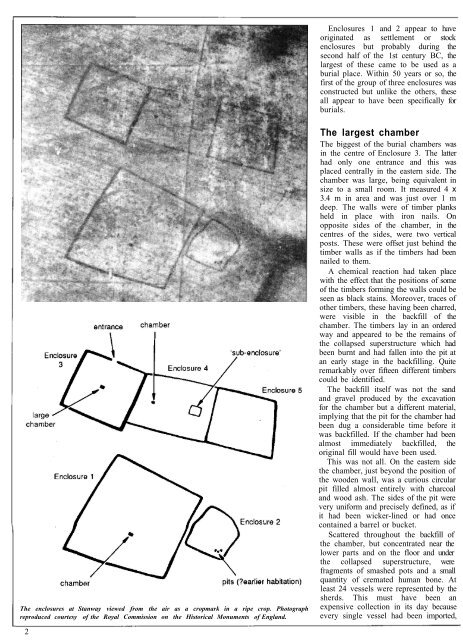The Colchester Archaeologist 1991-2 - Colchester Archaeological ...
The Colchester Archaeologist 1991-2 - Colchester Archaeological ...
The Colchester Archaeologist 1991-2 - Colchester Archaeological ...
Create successful ePaper yourself
Turn your PDF publications into a flip-book with our unique Google optimized e-Paper software.
Enclosures 1 and 2 appear to have<br />
originated as settlement or stock<br />
enclosures but probably during the<br />
second half of the 1st century BC, the<br />
largest of these came to be used as a<br />
burial place. Within 50 years or so, the<br />
first of the group of three enclosures was<br />
constructed but unlike the others, these<br />
all appear to have been specifically for<br />
burials.<br />
<strong>The</strong> enclosures at Stanway viewed from the air as a cropmark in a ripe crop. Photograph<br />
reproduced courtesy of the Royal Commission on the Historical Monuments of England.<br />
2<br />
<strong>The</strong> largest chamber<br />
<strong>The</strong> biggest of the burial chambers was<br />
in the centre of Enclosure 3. <strong>The</strong> latter<br />
had only one entrance and this was<br />
placed centrally in the eastern side. <strong>The</strong><br />
chamber was large, being equivalent in<br />
size to a small room. It measured 4 x<br />
3.4 m in area and was just over 1 m<br />
deep. <strong>The</strong> walls were of timber planks<br />
held in place with iron nails. On<br />
opposite sides of the chamber, in the<br />
centres of the sides, were two vertical<br />
posts. <strong>The</strong>se were offset just behind the<br />
timber walls as if the timbers had been<br />
nailed to them.<br />
A chemical reaction had taken place<br />
with the effect that the positions of some<br />
of the timbers forming the walls could be<br />
seen as black stains. Moreover, traces of<br />
other timbers, these having been charred,<br />
were visible in the backfill of the<br />
chamber. <strong>The</strong> timbers lay in an ordered<br />
way and appeared to be the remains of<br />
the collapsed superstructure which had<br />
been burnt and had fallen into the pit at<br />
an early stage in the backfilling. Quite<br />
remarkably over fifteen different timbers<br />
could be identified.<br />
<strong>The</strong> backfill itself was not the sand<br />
and gravel produced by the excavation<br />
for the chamber but a different material,<br />
implying that the pit for the chamber had<br />
been dug a considerable time before it<br />
was backfilled. If the chamber had been<br />
almost immediately backfilled, the<br />
original fill would have been used.<br />
This was not all. On the eastern side<br />
the chamber, just beyond the position of<br />
the wooden wall, was a curious circular<br />
pit filled almost entirely with charcoal<br />
and wood ash. <strong>The</strong> sides of the pit were<br />
very uniform and precisely defined, as if<br />
it had been wicker-lined or had once<br />
contained a barrel or bucket.<br />
Scattered throughout the backfill of<br />
the chamber, but concentrated near the<br />
lower parts and on the floor and under<br />
the collapsed superstructure, were<br />
fragments of smashed pots and a small<br />
quantity of cremated human bone. At<br />
least 24 vessels were represented by the<br />
sherds. This must have been an<br />
expensive collection in its day because<br />
every single vessel had been imported,

















